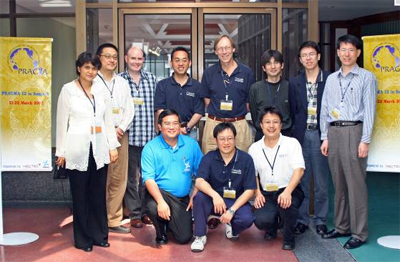Pacific Rim Researchers to Collaborate on Distributed Bioinformatics Analysis of Avian Flu Using Global Computational Data Grid
TATRC Funding to UC San Diego and University of Hawaii to Foster Stronger Ties for Collaboration with Institutions in China, Japan and Korea
San Diego, CA and Bangkok, Thailand, March 22, 2007-- Researchers at the University of California, San Diego and the University of Hawaii will use bioinformatics, grid computing and networking infrastructure, as well as collaborative ties to Asian institutions to learn more about Avian flu, in hopes of helping to head off a much-feared pandemic in the region of the world where the disease has already cost human lives.
|
"We will use modern high-throughput biology to annotate the biological structures of different subtypes of the avian influenza virus, at the same time as we study their variations," said principal investigator Peter Arzberger, director of Life Science Initiatives at UC San Diego. "We will also construct a grid infrastructure to support avian flu research -- an infrastructure that could one day handle research on other infectious diseases as well."
Added Arzberger: "Fighting a pandemic will also be easier if we put in place the infrastructure to replicate data, support medical informatics, and even assist in remote diagnosis."
UC San Diego will lead the one-year project, with more than $350,000 in funding from the Telemedicine and Advanced Technology Research Center (TATRC), part of the U.S. Army Medical Research and Material Command (USAMRMC). TATRC invests in telemedicine and advanced medical technologies in order to deliver world-class health care to military personnel. The increasing frequency of biological events relevant to national security, and current disease surveillance systems in the United States, require an integrated computational environment to support easy access to a set of universal tools, novel algorithmic approaches and tracking mechanisms for reproducibility at a global level.
Having Asian researchers involved in the TATRC-funded project lends an added dimension of urgency and depth to the U.S. research program. "Avian flu is very important to sites worldwide, but especially in Asia, where most of the known cases have occurred," said Wilfred Li, executive director of the UC San Diego-based National Biomedical Computation Resource (NBCR). "This partnership will give U.S. researchers enhanced access to new genomic information as it becomes available in the region. It will also promote global cooperation in case of a flu pandemic."
Institutions in three Asian nations will leverage TATRC's investment by funding their own researchers to work with their counterparts in California and Hawaii, as part of their ongoing collaboration in the National Science Foundation-funded Pacific Rim Applications and Grid Middleware Assembly (PRAGMA).
|
Pacific Rim institutions collaborate in PRAGMA to develop grid-enabled applications and coordinate deployment of the needed infrastructure throughout the Pacific region to allow data, computing, and other resource sharing. The announcement of the TATRC award coincides with PRAGMA 12, which runs March 20-22 in Bangkok, Thailand. The meeting is hosted by Thailand's National Electronics and Computer Technology Center (NECTEC), and the Thai National Grid Center (TGNC).
Five non-U.S. partners have pledged to fund collaboration on the avian flu virus project: Japan's National Institute for Advanced Industrial Science and Technology (AIST); China's Jilin University (JLU) and Computer Network Information Center (CNIC); as well as the Korea Institute for Science and Technology Information (KISTI) and Konkuk University (KU). Significantly, Malaysia's Universiti Sains Malaysia (USM) has pledged new funding for the collaborative project at the PRAGMA 12 workshop.
Flu vaccines are usually developed using attenuated viruses, but the new focus is on the use of reverse genetics techniques to combat emerging bird flu pandemic threats. To that end, researchers intend to:
- Characterize the function of the influenza viruses using a structure-based approach;
- Develop simulations of the molecular dynamics involving interactions among major factors that may determine the virulence of a virus; and
- Test whether the multinational collaboration can establish a successful, large-scale, distributed computational data grid.
Scientists at UC San Diego, the California Institute for Telecommunications and Information Technology (Calit2) and San Diego Supercomputer Center (SDSC) will use bioinformatics software, including the integrated Genome Analysis Pipeline (iGAP), to analyze avian flu genomes. (The iGAP suite of bioinformatics applications are designed specifically for protein structural homology recognition and functional annotation.) The San Diego-based researchers will also develop a robust production environment for routine computational analysis, using PRAGMA member-developed tools, including Grid Datafarm (Gfarm) and Community Scheduler Framework (CSF4), while making any new software publicly available through open-source licenses.
|
The Asian institutions -- all members of PRAGMA -- will host some U.S. students and researchers, while taking responsibility for specific tasks:
- JLU will support the scheduling of multiple clusters (CSF4) to distribute jobs transparently at multiple sites around the region;
- AIST will support the deployment of Gfarm in conjunction with researchers at the University of Tsukuba;
- KISTI, in conjunction with researchers at KU in Korea, will create an integrated portal environment for the computational pipeline using results of the Korea National e-Science Project by the Korean Ministry of Science and Technology (MOST);
- CNIC will develop a transparent web service layer for data access; and
- USM will contribute its natural compound database for use in virtual screening for new inhibitors and drug discovery.
CNIC will also become the central repository for the project's research data. The database will be distributed through the computational data grid, and will be accessible through web portals mirrored at partner sites. "The availability of a central repository that is built upon distributed information and data storage not only allows one to collect information more effectively, but also makes the data immediately available to researchers worldwide," said Kai Nan, director of CNIC's Network Technology and Applications Research Laboratory. "The end result is a dynamic research community response network that can meet the needs of a global response to a global threat such as the avian flu."
Much of the nitty-gritty work on the avian flu project will be done by students, at both the graduate and undergraduate level. "We'll be engaging students from the above institutions as an international research team," said NBCR's Li. "We will also send U.S. students and graduate researchers to work in the labs of our partners around Asia -- giving those students an experience that will equip them to do ongoing research in this field." This activity also leverages NSF's investment in the Pacific Rim undergraduate Education (PRIME) project, an undergraduate, research-abroad program awarded to UC San Diego.
"The next step for PRAGMA is a pragmatic one: to demonstrate that international team science can address pressing challenges in a way that might not be possible in one institution or just one country," said Arzberger. "We expect that this project will engage other researchers, both at other PRAGMA sites, e.g., the Universiti Sains Malaysia (USM), and at the National Biomedical Computation Resource, through the complementary, ongoing Avian flu Drug Discovery project led by Professors J. Andrew McCammon and Art Olson of NBCR, by sharing expertise and resources."
Related Links
TATRC
PRAGMA
PRAGMA 12
NECTEC
TGNC
NBCR
PRIME
Calit2
SDSC
UCSD
University of Hawaii
Jilin University
AIST
University of Tsukuba
KISTI
MOST
CNIC
Konkuk University
USM
U. Canterbury
Media Contacts
Media Contact: Doug Ramsey, 858-822-5825, dramsey@ucsd.edu



